Discontinuous Surface Ruptures and Slip Distributions in the Epicentral Region of the 2021 Mw7.4 Maduo Earthquake, China
Abstract
1. Introduction
2. Geological and Geodynamic Setting
3. Data and Methods
4. Surface Ruptures and Coseismic Slip Distributions in the Epicentral Region
4.1. Surface Ruptures in the Epicentral Region
4.2. Coseismic Slip Distributions in the Epicentral Region
5. Discussion
5.1. Discontinuous Surface Ruptures
5.2. Variation Coseismic Slip
5.3. Geomorphic Expression of Faults and Large Cumulative Offsets
5.4. Rupture Initiation in the Epicentral Region
6. Conclusions
Supplementary Materials
Author Contributions
Funding
Data Availability Statement
Acknowledgments
Conflicts of Interest
References
- Barka, A.A.; Kadinsky-Cade, K. Strike-slip fault geometry in Turkey and its influence on earthquake activity. Tectonics 1988, 7, 663–684. [Google Scholar] [CrossRef]
- Wesnousky, S.G. Seismological and structural evolution of strike-slip faults. Nature 1988, 335, 340–343. [Google Scholar] [CrossRef]
- Klinger, Y. Relation between continental strike-slip earthquake segmentation and thickness of the crust. J. Geophys. Res. Solid Earth 2010, 115, B07306. [Google Scholar] [CrossRef]
- King, G.; Nabelek, J. Role of fault bends in the initiation and termination of earthquake rupture. Science 1985, 228, 984–987. [Google Scholar] [CrossRef] [PubMed]
- Sibson, R.H. Stopping of earthquake ruptures at dilational fault jogs. Nature 1985, 316, 248–251. [Google Scholar] [CrossRef]
- Wesnousky, S.G. Predicting the endpoints of earthquake ruptures. Nature 2006, 444, 358–360. [Google Scholar] [CrossRef]
- Mildon, Z.K.; Toda, S.; Faure Walker, J.P.; Roberts, G.P. Evaluating models of Coulomb stress transfer: Is variable fault geometry important? Geophys. Res. Lett. 2016, 43, 12407–12414. [Google Scholar] [CrossRef]
- Sboras, S.; Pavlides, S.; Kilias, A.; Galanakis, D.; Chatziioannou, A.; Chatzipetros, A. The Geological Structure and Tectonic Complexity of Northern Thessaly That Hosted the March 2021 Seismic Crisis. Geotechnics 2022, 2, 935–960. [Google Scholar] [CrossRef]
- Han, L.; Liu-Zeng, J.; Yao, W.; Shao, Y.; Yuan, Z.; Wang, Y. Coseismic slip gradient at the western terminus of the 1920 Haiyuan Mw 7.9 earthquake. J. Struct. Geol. 2021, 152, 104442. [Google Scholar] [CrossRef]
- Schwartz, D.P.; Coppersmith, K.J. Fault behavior and characteristic earthquakes: Examples from the Wasatch and San Andreas Fault Zones. J. Geophys. Res. Solid Earth 1984, 89, 5681–5698. [Google Scholar] [CrossRef]
- Kase, Y.; Day, S.M. Spontaneous rupture processes on a bending fault. Geophys. Res. Lett. 2006, 33, L10302. [Google Scholar] [CrossRef]
- Wesnousky, S.G. Displacement and Geometrical Characteristics of Earthquake Surface Ruptures: Issues and Implications for Seismic-Hazard Analysis and the Process of Earthquake Rupture. Bull. Seismol. Soc. Amer. 2008, 98, 1609–1632. [Google Scholar] [CrossRef]
- Toda, S.; Enescu, B. Rate/state Coulomb stress transfer model for the CSEP Japan seismicity forecast. Earth Planets Space 2011, 63, 171–185. [Google Scholar] [CrossRef]
- Gold, P.O.; Oskin, M.E.; Elliott, A.J.; Hinojosa-Corona, A.; Taylor, M.H.; Kreylos, O.; Cowgill, E. Coseismic slip variation assessed from terrestrial lidar scans of the El Mayor–Cucapah surface rupture. Earth Planet. Sci. Lett. 2013, 366, 151–162. [Google Scholar] [CrossRef]
- Klinger, Y.; Michel, R.; King, G.C.P. Evidence for an earthquake barrier model from Mw∼7.8 Kokoxili (Tibet) earthquake slip-distribution. Earth Planet. Sci. Lett. 2006, 242, 354–364. [Google Scholar] [CrossRef]
- McGill, S.F.; Rubin, C.M. Surficial slip distribution on the central Emerson fault during the June 28, 1992, Landers earthquake, California. J. Geophys. Res. Solid Earth 1999, 104, 4811–4833. [Google Scholar] [CrossRef]
- Zachariasen, J.; Sieh, K. The transfer of slip between two en echelon strike-slip faults: A case study from the 1992 Landers earthquake, southern California. J. Geophys. Res. Solid Earth 1995, 100, 15281–15301. [Google Scholar] [CrossRef]
- Ansari, S. Role of fault structural heterogeneity in nucleation location of the Mw ≥ 7 Earthquakes in Iran. Environ. Earth Sci. 2021, 80, 730. [Google Scholar] [CrossRef]
- Barka, A. Slip distribution along the North Anatolian fault associated with the large earthquakes of the period 1939 to 1967. Bull. Seismol. Soc. Amer. 1996, 86, 1238–1254. [Google Scholar] [CrossRef]
- King, G.C.P. Speculations on the geometry of the initiation and termination processes of earthquake rupture and its relation to morphology and geological structure. Pure Appl. Geophys. 1986, 124, 567–585. [Google Scholar] [CrossRef]
- Liu-Zeng, J.; Yao, W.; Liu, X.; Shao, Y.; Wang, W.; Han, L.; Wang, Y.; Zeng, X.; Li, J.; Wang, Z.; et al. High-resolution Structure-from-Motion models covering 160 km-long surface ruptures of the 2021 Mw 7.4 Madoi earthquake in northern Tibet. Earthq. Res. Adv. 2022, 2, 100140. [Google Scholar] [CrossRef]
- Pan, J.; Li, H.; Chevalier, M.-L.; Tapponnier, P.; Bai, M.; Li, C.; Liu, F.; Liu, D.; Wu, K.; Wang, P.; et al. Coseismic rupture of the 2021, Mw7.4 Maduo earthquake (northern Tibet): Short-cutting of the Kunlun fault big bend. Earth Planet. Sci. Lett. 2022, 594, 117703. [Google Scholar] [CrossRef]
- Ren, J.; Xu, X.; Zhang, G.; Wang, Q.; Zhang, Z.; Gai, H.; Kang, W. Coseismic surface ruptures, slip distribution, and 3D seismogenic fault for the 2021 Mw 7.3 Maduo earthquake, central Tibetan Plateau, and its tectonic implications. Tectonophysics 2022, 827, 229275. [Google Scholar] [CrossRef]
- Wei, S.; Zeng, H.; Shi, Q.; Liu, J.; Luo, H.; Hu, W.-L.; Li, Y.; Wang, W.; Ma, Z.; Liu-Zeng, J. Simultaneous rupture propagation through fault bifurcation of the 2021 Mw7. 4 Maduo earthquake. Earth Space Sci. Open Arch. 2022, 49, e2022GL100283. [Google Scholar]
- Yao, W.; Wang, Z.; Liu, J.; Liu, X.; Han, L.; Shao, Y.; Wang, W.; Xu, J.; Qin, K.; Gao, Y.; et al. Discussion on coseismic surface rupture length of the 2021 Mw7.4 Maduo earthquake, Qinghai, China. Seismol. Geol. 2022, 44, 541–559. (In Chinese) [Google Scholar] [CrossRef]
- Yuan, Z.; Li, T.; Su, P.; Sun, H.; Ha, G.; Guo, P.; Chen, G.; Thompson Jobe, J. Large Surface-Rupture Gaps and Low Surface Fault Slip of the 2021 Mw 7.4 Maduo Earthquake Along a Low-Activity Strike-Slip Fault, Tibetan Plateau. Geophys. Res. Lett. 2022, 49, e2021GL096874. [Google Scholar] [CrossRef]
- Han, L.; Liu, J.; Yao, W.; Wang, W.; Liu, X.; Gao, Y.; Shao, Y.; Li, J. Detailed mapping of the surface near the epicenter segment of the 1021 Maduo Mw7.4 earthquake and discussion on distributed rupture in the stepover. Seismol. Geol. 2022, 44, 484–505. (In Chinese) [Google Scholar] [CrossRef]
- Elliott, A.J.; Dolan, J.F.; Oglesby, D.D. Evidence from coseismic slip gradients for dynamic control on rupture propagation and arrest through stepovers. J. Geophys. Res. Solid Earth 2009, 114, B02313. [Google Scholar] [CrossRef]
- Rockwell, T.K.; Klinger, Y. Surface Rupture and Slip Distribution of the 1940 Imperial Valley Earthquake, Imperial Fault, Southern California: Implications for Rupture Segmentation and Dynamics. Bull. Seismol. Soc. Amer. 2013, 103, 629–640. [Google Scholar] [CrossRef]
- Xu, X.; Yu, G.; Klinger, Y.; Tapponnier, P.; Van Der Woerd, J. Reevaluation of surface rupture parameters and faulting segmentation of the 2001 Kunlunshan earthquake (Mw7.8), northern Tibetan Plateau, China. J. Geophys. Res. Solid Earth 2006, 111, B05316. [Google Scholar] [CrossRef]
- Tapponnier, P.; Xu, Z.; Roger, F.; Meyer, B.; Arnaud, N.; Wittlinger, G.; Yang, J. Oblique Stepwise Rise and Growth of the Tibet Plateau. Science 2001, 294, 1671–1677. [Google Scholar] [CrossRef]
- Wang, W.; Fang, L.; Wu, J.; Tu, H.; Chen, L.; Lai, G.; Zhang, L. Aftershock sequence relocation of the 2021 MS7.4 Maduo Earthquake, Qinghai, China. Sci. China Earth Sci. 2021, 51, 1193–1202. [Google Scholar] [CrossRef]
- Deng, Q.; Chen, S.; Song, F.; Zhu, S.; Wang, Y.; Zhang, W.; Jiao, D.; Burchfiel, B.C.; Molnar, P.; Royden, L.; et al. Variations in the Geometry and Amount of Slip on the Haiyuan (Nanxihaushan) Fault Zone, China and the Surface Rupture of the 1920 Haiyuan Earthquake. Earthq. Source Mech. 1986, 37, 169–182. [Google Scholar]
- Li, H.; Pan, J.; Lin, A.; Sun, Z.; Liu, D.; Zhang, J.; Li, C.; Liu, K.; Chevalier, M.L.; Yun, K.; et al. Coseismic Surface Ruptures Associated with the 2014 Mw 6.9 Yutian Earthquake on the Altyn Tagh Fault, Tibetan Plateau. Bull. Seismol. Soc. Amer. 2016, 106, 595–608. [Google Scholar] [CrossRef]
- Liu-Zeng, J.; Zhang, Z.; Wen, L.; Tapponnier, P.; Sun, J.; Xing, X.; Hu, G.; Xu, Q.; Zeng, L.; Ding, L.; et al. Coseismic ruptures of the 12 May 2008, Ms 8.0 Wenchuan earthquake, Sichuan: East–west crustal shortening on oblique, parallel thrusts along the eastern edge of Tibet. Earth Planet. Sci. Lett. 2009, 286, 355–370. [Google Scholar] [CrossRef]
- IGCEA; NBCEA. Active Haiyuan Fault Zone Monograph; Seismological Publishing House: Beijing, China, 1990. [Google Scholar]
- Klinger, Y.; Xu, X.W.; Tapponnier, P.; Van der Woerd, J.; Lasserre, C.; King, G. High-resolution satellite imagery mapping of the surface rupture and slip distribution of the M-W similar to 7.8, 14 November 2001 Kokoxili Earthquake, Kunlun Fault, northern Tibet, China. Bull. Seismol. Soc. Amer. 2005, 95, 1970–1987. [Google Scholar] [CrossRef]
- Ren, Z.; Zhang, Z. Structural analysis of the 1997 Mw 7.5 Manyi earthquake and the kinematics of the Manyi fault, central Tibetan Plateau. J. Asian Earth Sci. 2019, 179, 149–164. [Google Scholar] [CrossRef]
- Pierce, I.; Williams, A.; Koehler, R.D.; Chupik, C. High-Resolution Structure-From-Motion Models and Orthophotos of the Southern Sections of the 2019 Mw 7.1 and 6.4 Ridgecrest Earthquakes Surface Ruptures. Seismol. Res. Lett. 2020, 91, 2124–2126. [Google Scholar] [CrossRef]
- Rodriguez Padilla, A.M.; Quintana, M.A.; Prado, R.M.; Aguilar, B.J.; Shea, T.A.; Oskin, M.E.; Garcia, L. Near-Field High-Resolution Maps of the Ridgecrest Earthquakes from Aerial Imagery. Seismol. Res. Lett. 2021, 93, 494–499. [Google Scholar] [CrossRef]
- Westoby, M.J.; Brasington, J.; Glasser, N.F.; Hambrey, M.J.; Reynolds, J.M. ‘Structure-from-Motion’ photogrammetry: A low-cost, effective tool for geoscience applications. Geomorphology 2012, 179, 300–314. [Google Scholar] [CrossRef]
- Antoine, S.L.; Klinger, Y.; Delorme, A.; Wang, K.; Bürgmann, R.; Gold, R.D. Diffuse Deformation and Surface Faulting Distribution from Submetric Image Correlation along the 2019 Ridgecrest, California, Ruptures. Bull. Seismol. Soc. Amer. 2021, 111, 2275–2302. [Google Scholar] [CrossRef]
- Milliner, C.W.D.; Dolan, J.F.; Hollingsworth, J.; Leprince, S.; Ayoub, F.; Sammis, C.G. Quantifying near-field and off-fault deformation patterns of the 1992 Mw 7.3 Landers earthquake. Geochem. Geophys. Geosystems 2015, 16, 1577–1598. [Google Scholar] [CrossRef]
- Vallage, A.; Klinger, Y.; Lacassin, R.; Delorme, A.; Pierrot-Deseilligny, M. Geological structures control on earthquake ruptures: The Mw7.7, 2013, Balochistan earthquake, Pakistan. Geophys. Res. Lett. 2016, 43, 10155–110163. [Google Scholar] [CrossRef]
- Peltzer, G.; Saucier, F. Present-day kinematics of Asia derived from geologic fault rates. J. Geophys. Res. Solid Earth 1996, 101, 27943–27956. [Google Scholar] [CrossRef]
- Molnar, P.; Tapponnier, P. Cenozoic Tectonics of Asia: Effects of a Continental Collision: Features of recent continental tectonics in Asia can be interpreted as results of the India-Eurasia collision. Science 1975, 189, 419–426. [Google Scholar] [CrossRef]
- Tapponnier, P.; Molnar, P. Active faulting and tectonics in China. J. Geophys. Res. 1977, 82, 2905–2930. [Google Scholar] [CrossRef]
- Zhang, P.-Z.; Shen, Z.; Wang, M.; Gan, W.; Bürgmann, R.; Molnar, P.; Wang, Q.; Niu, Z.; Sun, J.; Wu, J.; et al. Continuous deformation of the Tibetan Plateau from global positioning system data. Geology 2004, 32, 809–812. [Google Scholar] [CrossRef]
- Haibing, L.; Van der Woerd, J.; Tapponnier, P.; Klinger, Y.; Xuexiang, Q.; Jingsui, Y.; Yintang, Z. Slip rate on the Kunlun fault at Hongshui Gou, and recurrence time of great events comparable to the 14/11/2001, Mw ∼ 7.9 Kokoxili earthquake. Earth Planet. Sci. Lett. 2005, 237, 285–299. [Google Scholar] [CrossRef]
- Bai, M.; Chevalier, M.-L.; Pan, J.; Replumaz, A.; Leloup, P.H.; Métois, M.; Li, H. Southeastward increase of the late Quaternary slip-rate of the Xianshuihe fault, eastern Tibet. Geodynamic and seismic hazard implications. Earth Planet. Sci. Lett. 2018, 485, 19–31. [Google Scholar] [CrossRef]
- Chevalier, M.-L.; Leloup, P.H.; Replumaz, A.; Pan, J.; Métois, M.; Li, H. Temporally constant slip rate along the Ganzi fault, NW Xianshuihe fault system, eastern Tibet. GSA Bull. 2017, 130, 396–410. [Google Scholar] [CrossRef]
- Deng, Q.; Zhang, P.; Ran, Y.; Yang, X.; Min, W.; Chu, Q. Basic characteristics of tectonics in China. Sci. China Earth Sci. 2002, 1020–1030+1057. (In Chinese) [Google Scholar]
- Zhang, P.; Deng, Q.; Zhang, G.; Ma, J.; Gan, W.; Min, W.; Mao, F.; Wang, Q. Seismic activities and tectonic blocks in mainland China. Sci. China Earth Sci. 2003, 12–20. (In Chinese) [Google Scholar]
- Wang, H.; Xu, C.; Ge, L. Coseismic deformation and slip distribution of the 1997 Mw7.5 Manyi, Tibet, earthquake from InSAR measurements. J. Geodyn. 2007, 44, 200–212. [Google Scholar] [CrossRef]
- Peltzer, G.; Crampé, F.; King, G. Evidence of Nonlinear Elasticity of the Crust from the Mw7.6 Manyi (Tibet) Earthquake. Science 1999, 286, 272–276. [Google Scholar] [CrossRef] [PubMed]
- Yuan, Z.; Liu-Zeng, J.; Li, X.; Xu, J.; Yao, W.; Han, L.; Li, T. Detailed mapping of the surface rupture of the 12 February 2014 Yutian Ms7.3 earthquake, Altyn Tagh fault, Xinjiang, China. Sci. China Earth Sci. 2021, 64, 127–147. [Google Scholar] [CrossRef]
- Li, X.; Xu, W.; Jónsson, S.; Klinger, Y.; Zhang, G. Source Model of the 2014 Mw 6.9 Yutian Earthquake at the Southwestern End of the Altyn Tagh Fault in Tibet Estimated from Satellite Images. Seismol. Res. Lett. 2020, 91, 3161–3170. [Google Scholar] [CrossRef]
- Liu-Zeng, J.; Wang, P.; Zhang, Z.; Li, Z.; Cao, Z.; Zhang, J.; Yuan, X.; Wang, W.; Xing, X. Liquefaction in western Sichuan Basin during the 2008 Mw 7.9 Wenchuan earthquake, China. Tectonophysics 2017, 694, 214–238. [Google Scholar] [CrossRef]
- Liu-Zeng, J.; Sun, J.; Wang, P.; Hudnut, K.W.; Ji, C.; Zhang, Z.; Xu, Q.; Wen, L. Surface ruptures on the transverse Xiaoyudong fault: A significant segment boundary breached during the 2008 Wenchuan earthquake, China. Tectonophysics 2012, 580, 218–241. [Google Scholar] [CrossRef]
- Liu-Zeng, J.; Wen, L.; Sun, J.; Zhang, Z.; Hu, G.; Xing, X.; Zeng, L.; Xu, Q. Surficial Slip and Rupture Geometry on the Beichuan Fault near Hongkou during the Mw 7.9 Wenchuan Earthquake, China. Bull. Seismol. Soc. Amer. 2010, 100, 2615–2650. [Google Scholar] [CrossRef]
- Klinger, Y.; Ji, C.; Shen, Z.-K.; Bakun, W.H. Introduction to the Special Issue on the 2008 Wenchuan, China, Earthquake. Bull. Seismol. Soc. Amer. 2010, 100, 2353–2356. [Google Scholar] [CrossRef][Green Version]
- Xu, X.; Wen, X.; Yu, G.; Chen, G.; Klinger, Y.; Hubbard, J.; Shaw, J. Coseismic reverse- and oblique-slip surface faulting generated by the 2008 Mw 7.9 Wenchuan earthquake, China. Geology 2009, 37, 515–518. [Google Scholar] [CrossRef]
- Xu, X.; Chen, W.; Ma, W.; Yu, G.; Chen, G. Surface Rupture of the Kunlunshan Earthquake (Ms 8.1), Northern Tibetan Plateau, China. Seismol. Res. Lett. 2002, 73, 884–892. [Google Scholar] [CrossRef]
- Yue, H.; Shen, Z.-K.; Zhao, Z.; Wang, T.; Cao, B.; Li, Z.; Bao, X.; Zhao, L.; Song, X.; Ge, Z.; et al. Rupture process of the 2021 M7.4 Maduo earthquake and implication for deformation mode of the Songpan-Ganzi terrane in Tibetan Plateau. Proc. Natl. Acad. Sci. USA 2022, 119, e2116445119. [Google Scholar] [CrossRef] [PubMed]
- Liang, M.; Yang, Y.; Du, F.; Gong, Y.; Wei, W.; Zhao, M.; He, Q. Late quaternary activity of the central segment of the dari fault and restudy of the surface rupture zone of the 1947 m73/4 dari earthquake, qinghai province. Seismol. Geol. 2020, 42, 703–714. (In Chinese) [Google Scholar] [CrossRef]
- Ren, J.; Xu, X.; Zhang, S.; Yeats, R.S.; Chen, J.; Zhu, A.; Liu, S. Surface rupture of the 1933 M 7.5 Diexi earthquake in eastern Tibet: Implications for seismogenic tectonics. Geophys. J. Int. 2018, 212, 1627–1644. [Google Scholar] [CrossRef]
- Brown, M.; Lowe, D.G. Unsupervised 3D object recognition and reconstruction in unordered datasets. In Proceedings of the Fifth International Conference on 3-D Digital Imaging and Modeling (3DIM’05), Ottawa, ON, Canada, 13–16 June 2005; pp. 56–63. [Google Scholar]
- Fonstad, M.A.; Dietrich, J.T.; Courville, B.C.; Jensen, J.L.; Carbonneau, P.E. Topographic structure from motion: A new development in photogrammetric measurement. Earth Surf. Process. Landf. 2013, 38, 421–430. [Google Scholar] [CrossRef]
- Chen, K.; Avouac, J.-P.; Geng, J.; Liang, C.; Zhang, Z.; Li, Z.; Zhang, S. The 2021 Mw 7.4 Madoi Earthquake: An Archetype Bilateral Slip-Pulse Rupture Arrested at a Splay Fault. Geophys. Res. Lett. 2022, 49, e2021GL095243. [Google Scholar] [CrossRef]
- Choi, J.-H.; Klinger, Y.; Ferry, M.; Ritz, J.-F.; Kurtz, R.; Rizza, M.; Bollinger, L.; Davaasambuu, B.; Tsend-Ayush, N.; Demberel, S. Geologic Inheritance and Earthquake Rupture Processes: The 1905 M ≥ 8 Tsetserleg-Bulnay Strike-Slip Earthquake Sequence, Mongolia. J. Geophys. Res. Solid Earth 2018, 123, 1925–1953. [Google Scholar] [CrossRef]
- Spotila, J.A.; Sieh, K. Geologic investigations of a “slip gap” in the surficial ruptures of the 1992 Landers earthquake, southern California. J. Geophys. Res. Solid Earth 1995, 100, 543–559. [Google Scholar] [CrossRef]
- Pan, J.; Li, H.; Wu, F.; Li, N.; Guo, R.; Zhang, W. Surface rupture characteristics, rupture mechanics, and rupture process of the Yushu earthquake (Ms7. 1), 14/04/2010. Acta Petrol. Sin. 2011, 27, 3449–3459. [Google Scholar]
- Li, C.; Lv, L.; Wang, X.; Li, X. Late quaternary slip behavior of the Yushu fault and the 2010 Ms 7.1 Yushu earthquake, eastern Tibetan Plateau. J. Struct. Geol. 2019, 118, 284–298. [Google Scholar] [CrossRef]
- Tobita, M.; Nishimura, T.; Kobayashi, T.; Hao, K.X.; Shindo, Y. Estimation of coseismic deformation and a fault model of the 2010 Yushu earthquake using PALSAR interferometry data. Earth Planet. Sci. Lett. 2011, 307, 430–438. [Google Scholar] [CrossRef]
- Quigley, M.C.; Bastin, S.; Bradley, B.A. Recurrent liquefaction in Christchurch, New Zealand, during the Canterbury earthquake sequence. Geology 2013, 41, 419–422. [Google Scholar] [CrossRef]
- Chen, W.; Wang, D.; Zhang, C.; Yao, Q.; Si, H. Estimating Seismic Intensity Maps of the 2021 Mw 7.3 Madoi, Qinghai and Mw 6.1 Yangbi, Yunnan, China Earthquakes. J. Earth Sci. 2022, 33, 839–846. [Google Scholar] [CrossRef]
- Wang, W.; Liu-Zeng, J.; Shao, Y.; Wang, Z.; Han, L.; Shen, X.; Qin, K.; Gao, Y.; Yao, W.; Hu, G.; et al. Mapping of Soil Liquefaction Associated with the 2021 Mw 7.4 Maduo (Madoi) Earthquake Based on the UAV Photogrammetry Technology. Remote Sens. 2023, 15, 1032. [Google Scholar] [CrossRef]
- Liu-Zeng, J.; Liu, Z.; Liu, X.; Milliner, C.; Rodriguez Padilla, A.M.; Xu, S.; Avouac, J.-P.; Yao, W.; Klinger, Y.; Han, L.; et al. Fault orientation trumps fault maturity in controlling coseismic rupture characteristics of the 2021 Maduo earthquake. AGU Adv. 2024, 5, e2023AV001134. [Google Scholar] [CrossRef]
- Scholz, C.H. Earthquakes and friction laws. Nature 1998, 391, 37–42. [Google Scholar] [CrossRef]
- Sieh, K.; Jones, L.; Hauksson, E.; Hudnut, K.; Eberhart-Phillips, D.; Heaton, T.; Hough, S.; Hutton, K.; Kanamori, H.; Lilje, A.; et al. Near-Field Investigations of the Landers Earthquake Sequence, April to July 1992. Science 1993, 260, 171–176. [Google Scholar] [CrossRef]
- Liu-Zeng, J.; Klinger, Y.; Xu, X.; Lasserre, C.; Chen, G.; Chen, W.; Tapponnier, P.; Zhang, B. Millennial recurrence of large earthquakes on the Haiyuan fault near Songshan, Gansu Province, China. Bull. Seismol. Soc. Amer. 2007, 97, 14–34. [Google Scholar] [CrossRef]
- Liu-Zeng, J.; Shao, Y.; Klinger, Y.; Xie, K.; Yuan, D.; Lei, Z. Variability in magnitude of paleoearthquakes revealed by trenching and historical records, along the Haiyuan Fault, China. J. Geophys. Res. Solid Earth 2015, 120, 8304–8333. [Google Scholar] [CrossRef]
- Cheng, C.; Wang, D.; Yao, Q.; Fang, L.; Xu, S.; Huang, Z.; Liu, T.; Wang, Z.; Huang, X. The 2021 Mw 7.3 Madoi, China Earthquake: Transient Supershear Ruptures on a Presumed Immature Strike-Slip Fault. J. Geophys. Res. Solid Earth 2023, 128, e2022JB024641. [Google Scholar] [CrossRef]
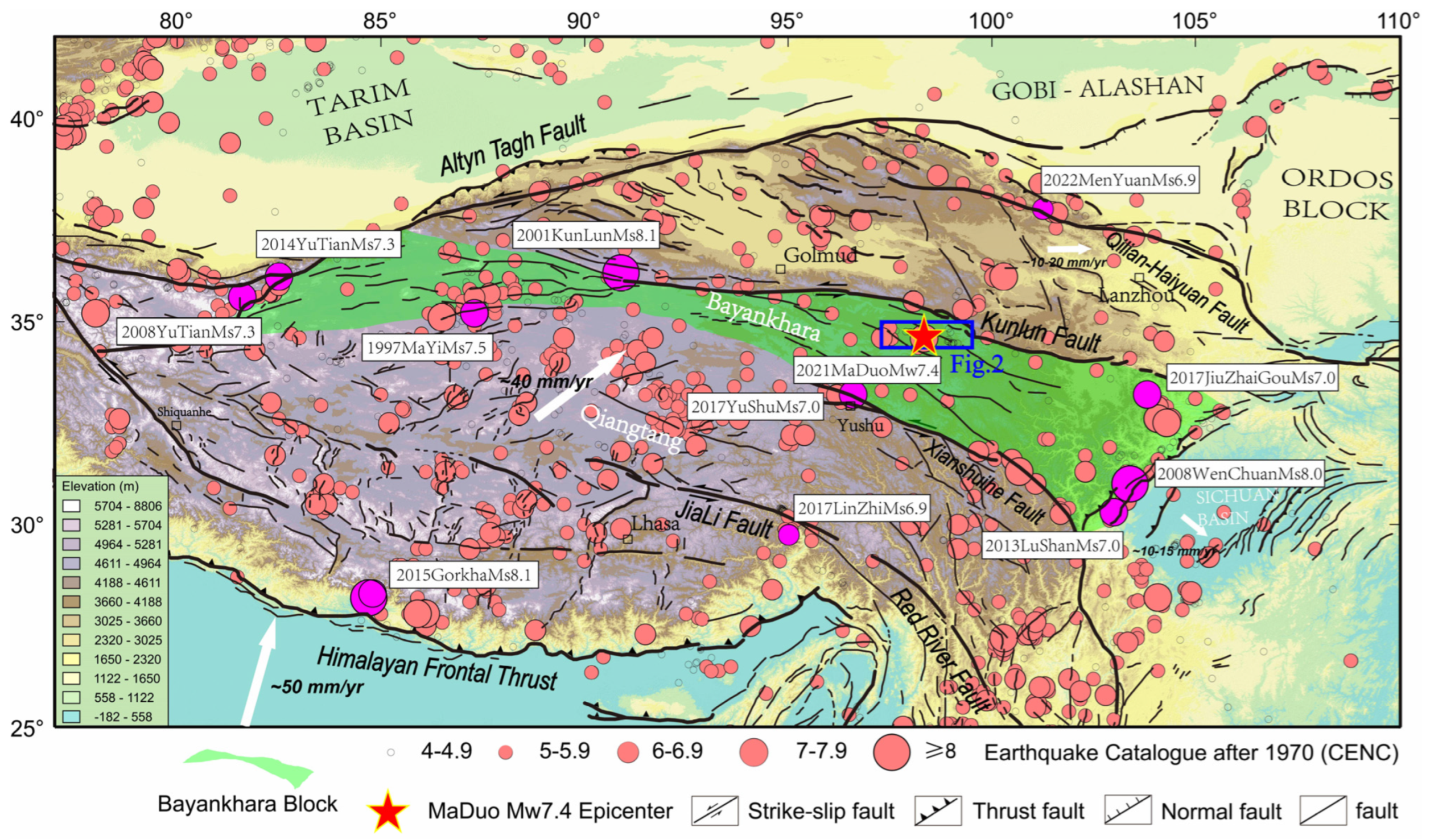
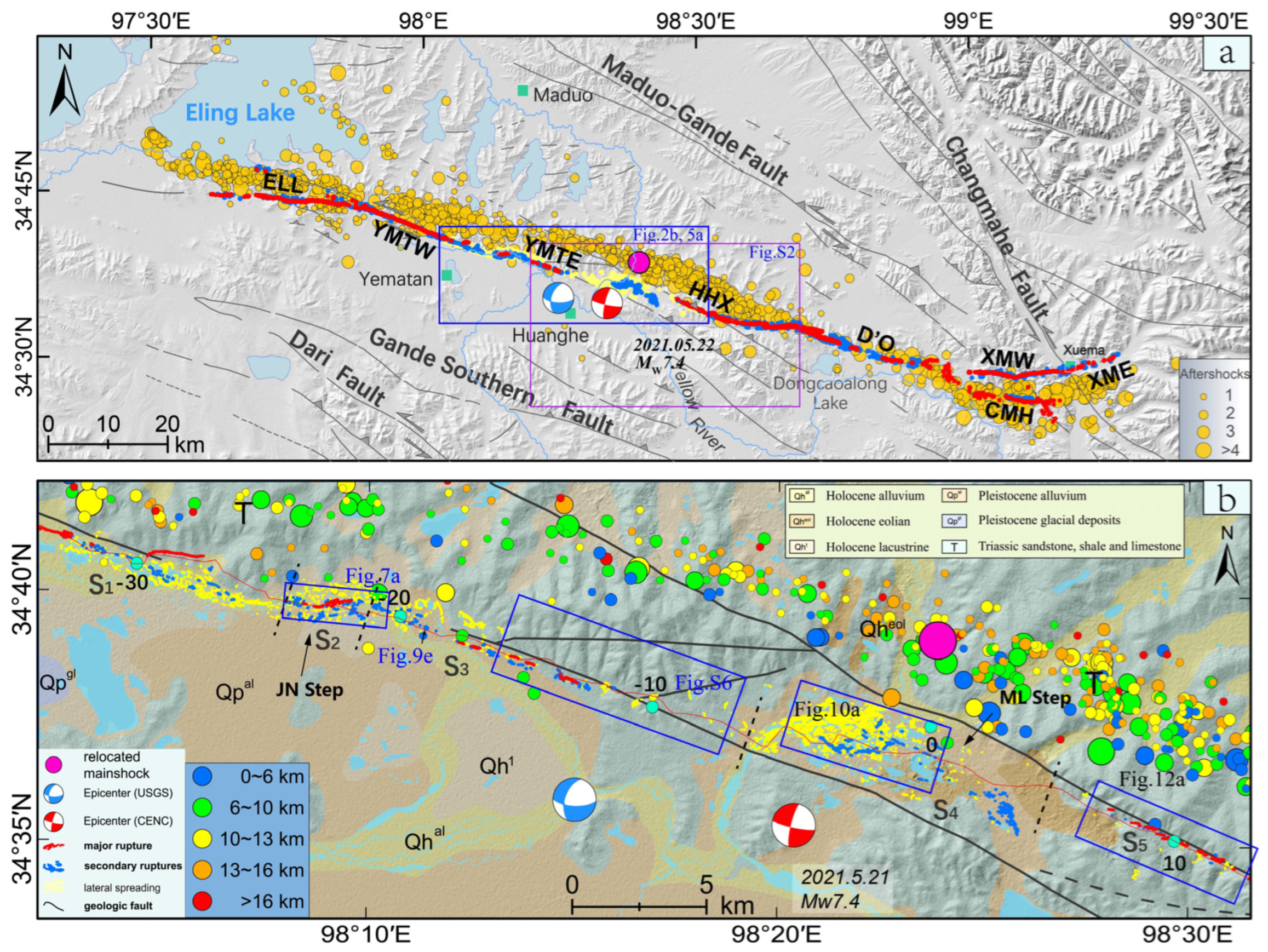
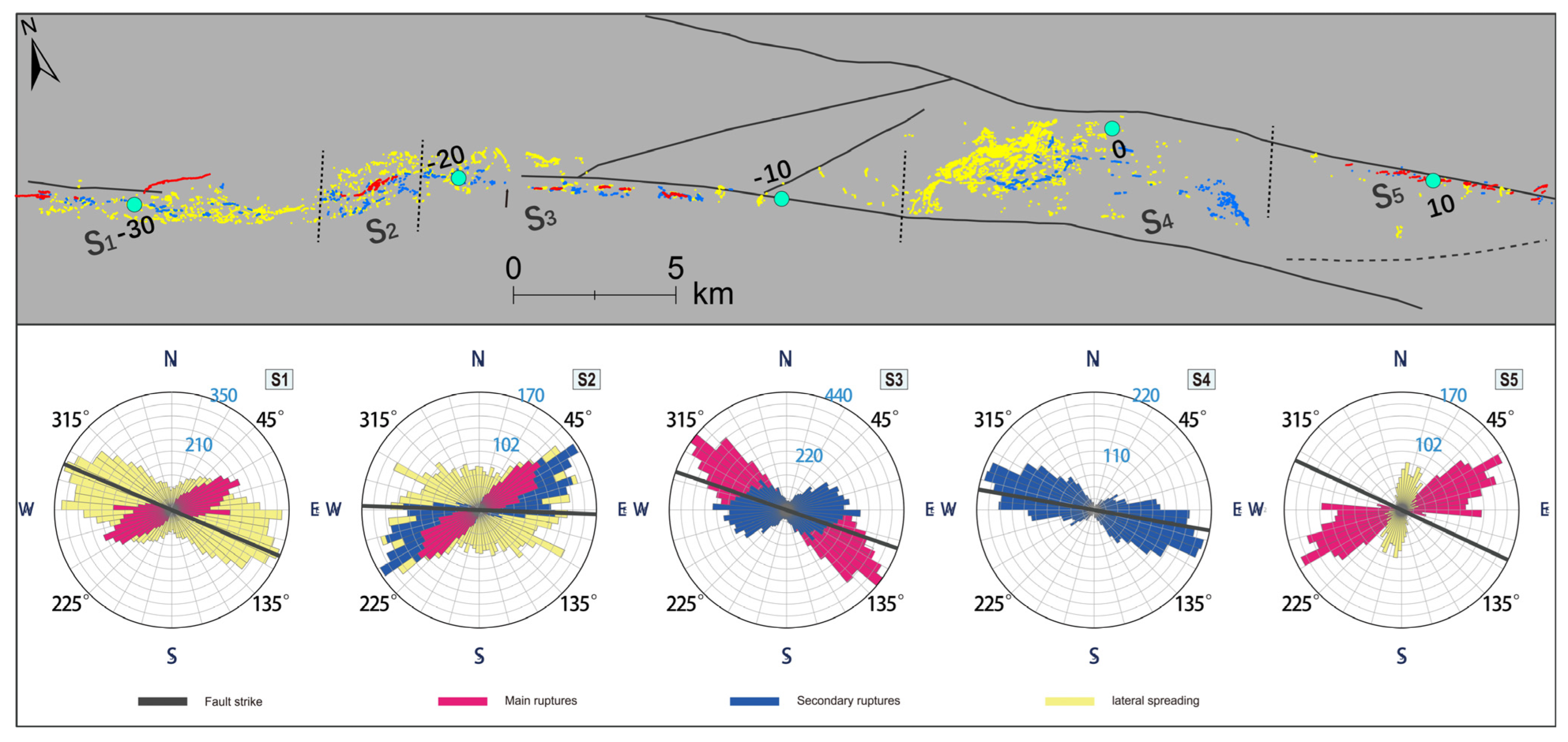
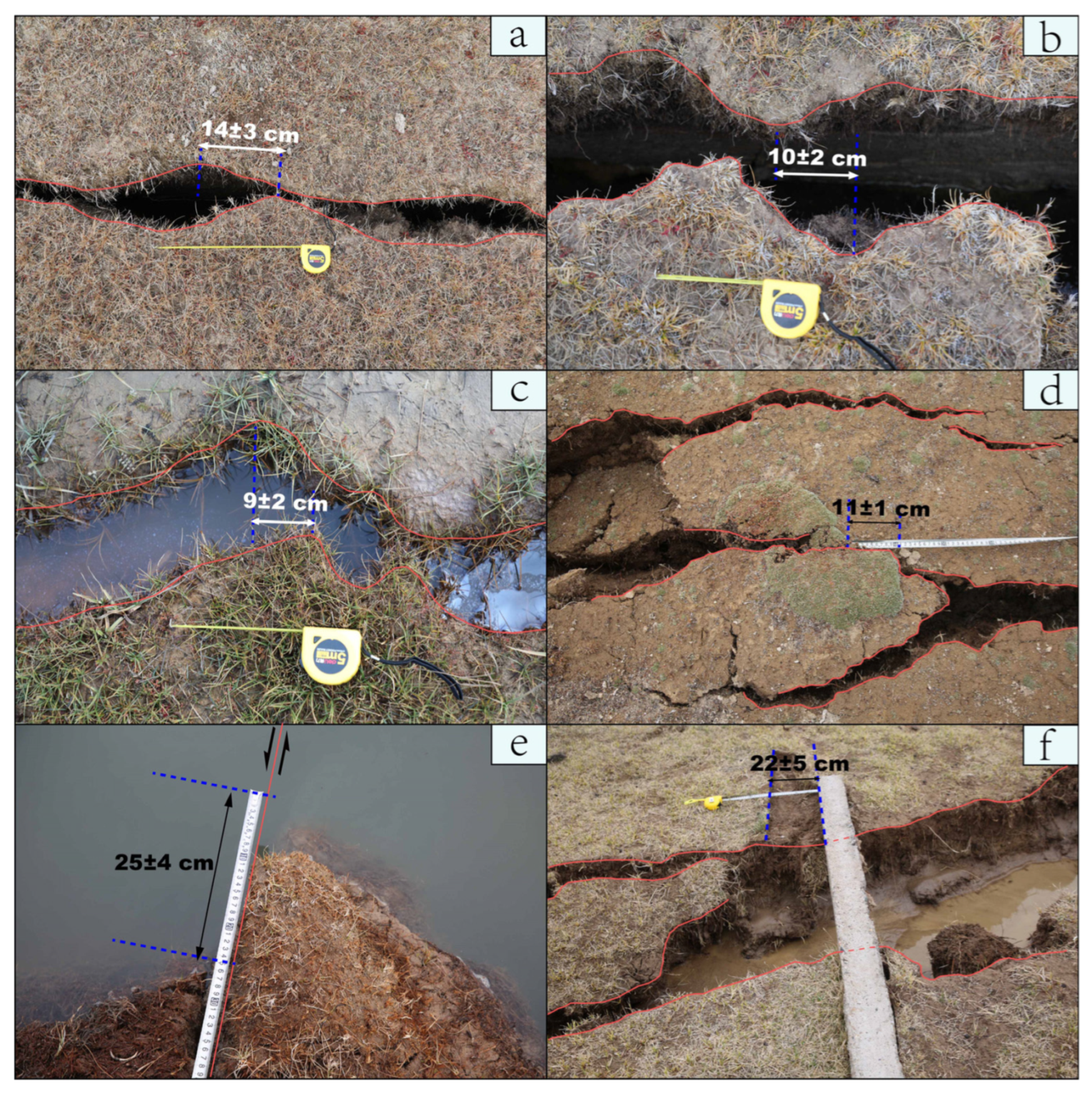

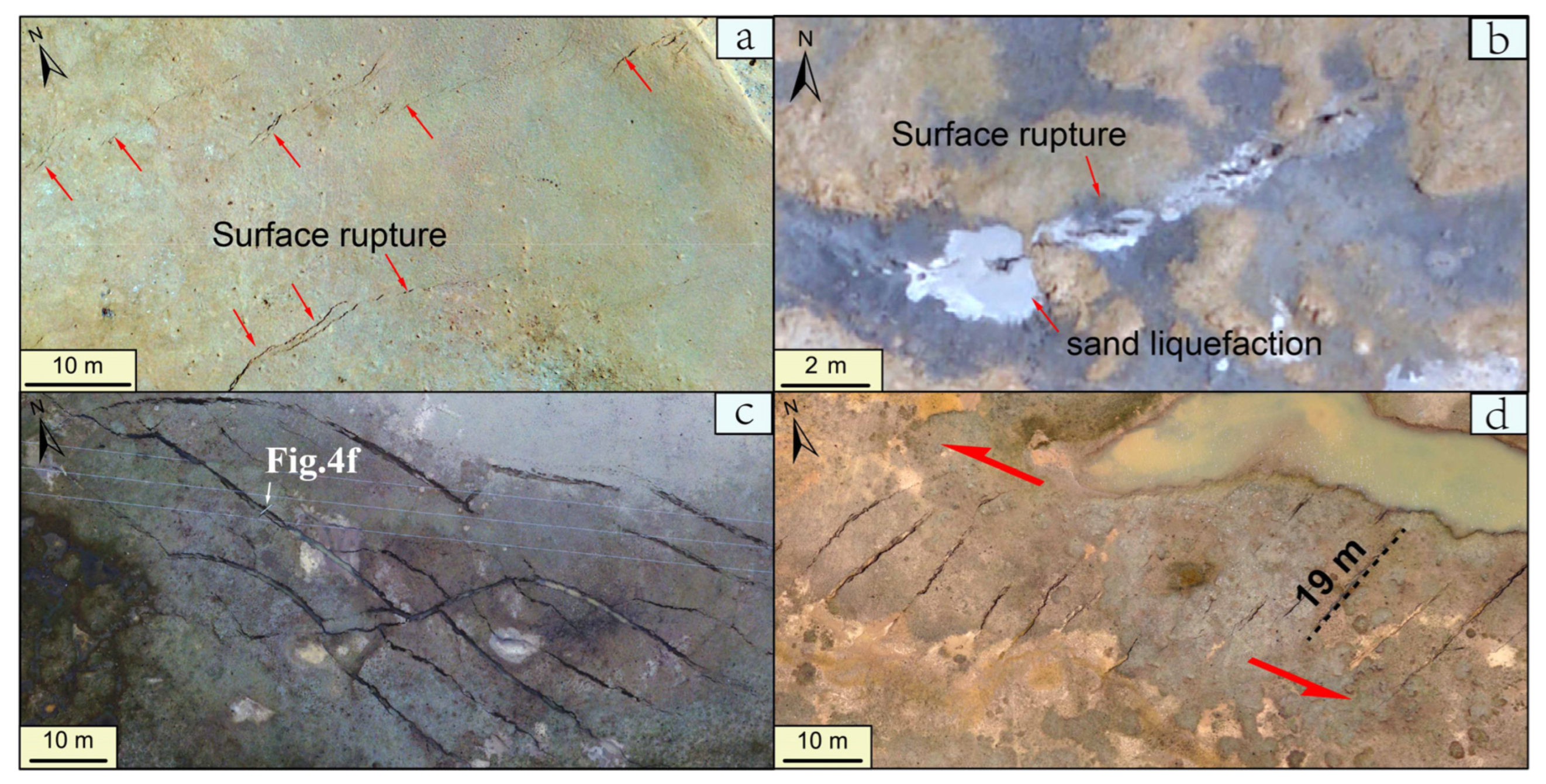
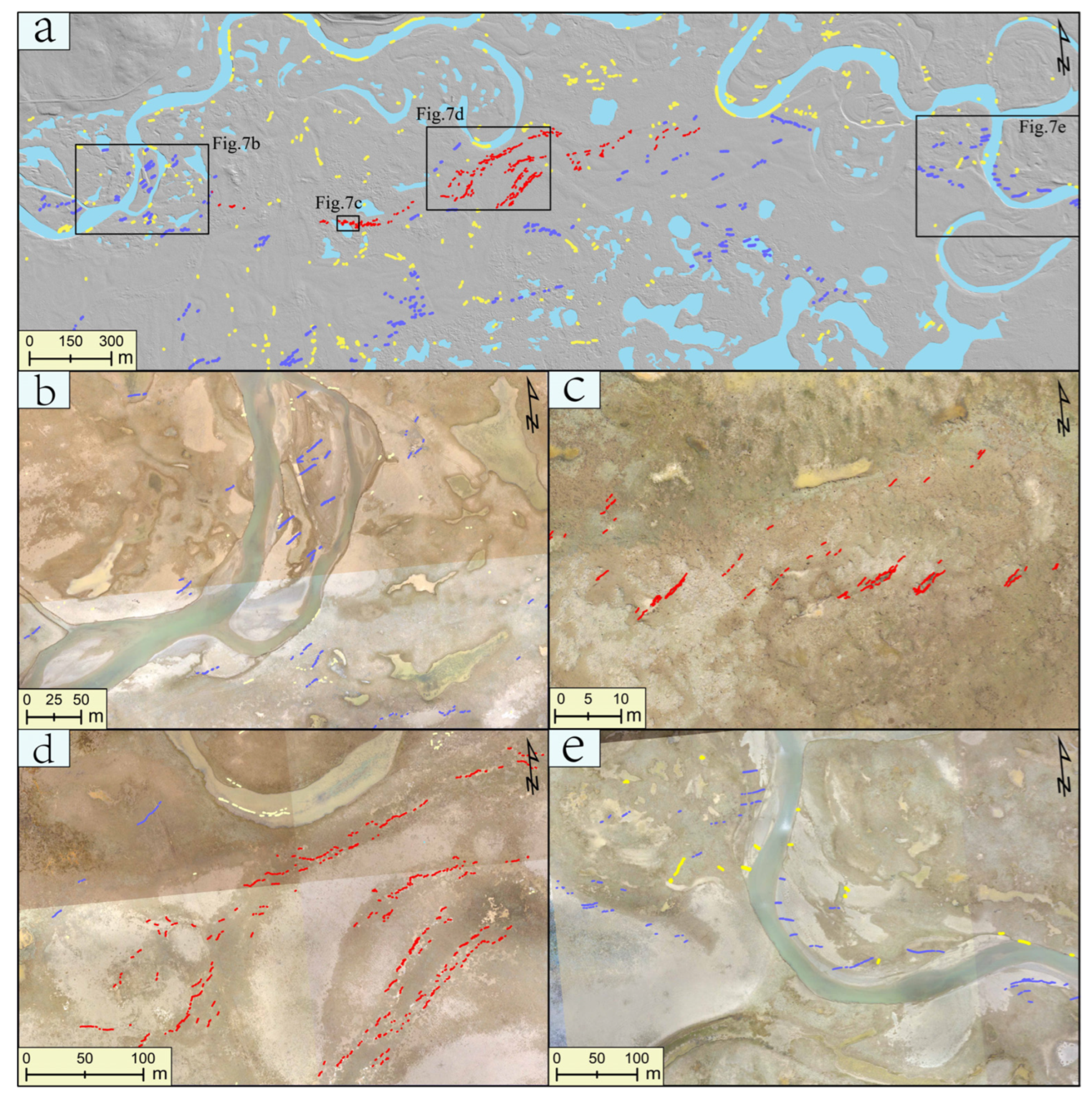
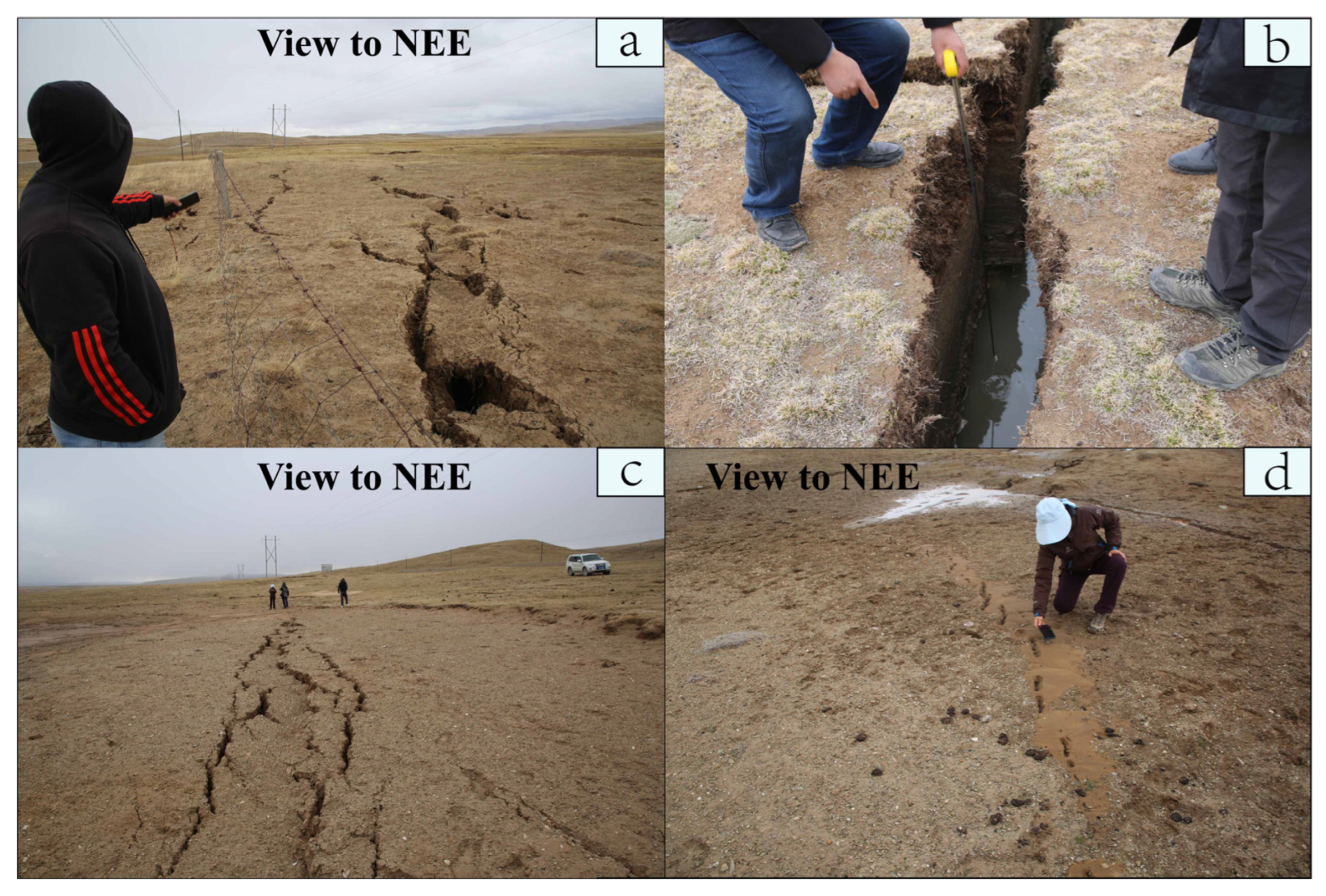
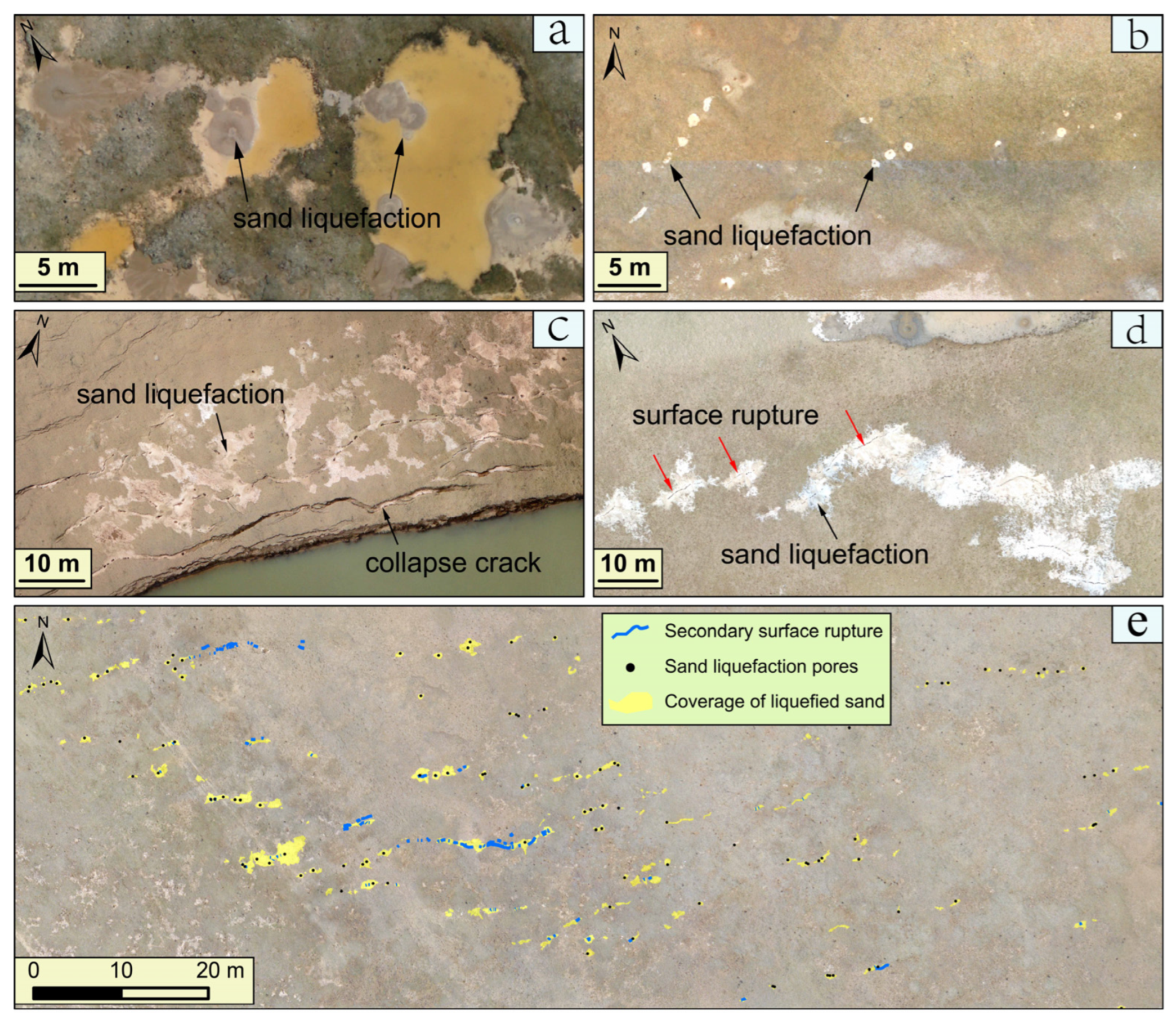
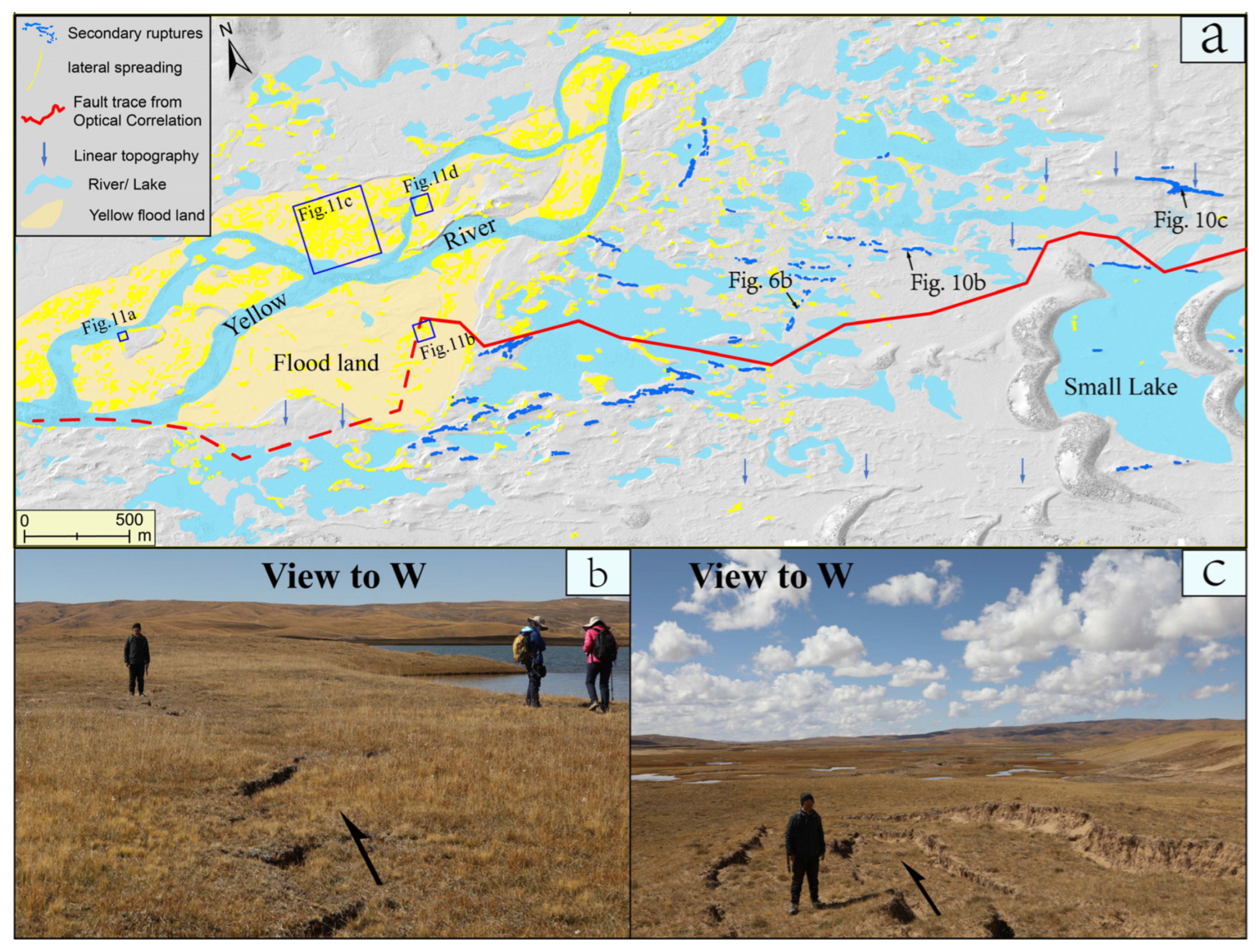



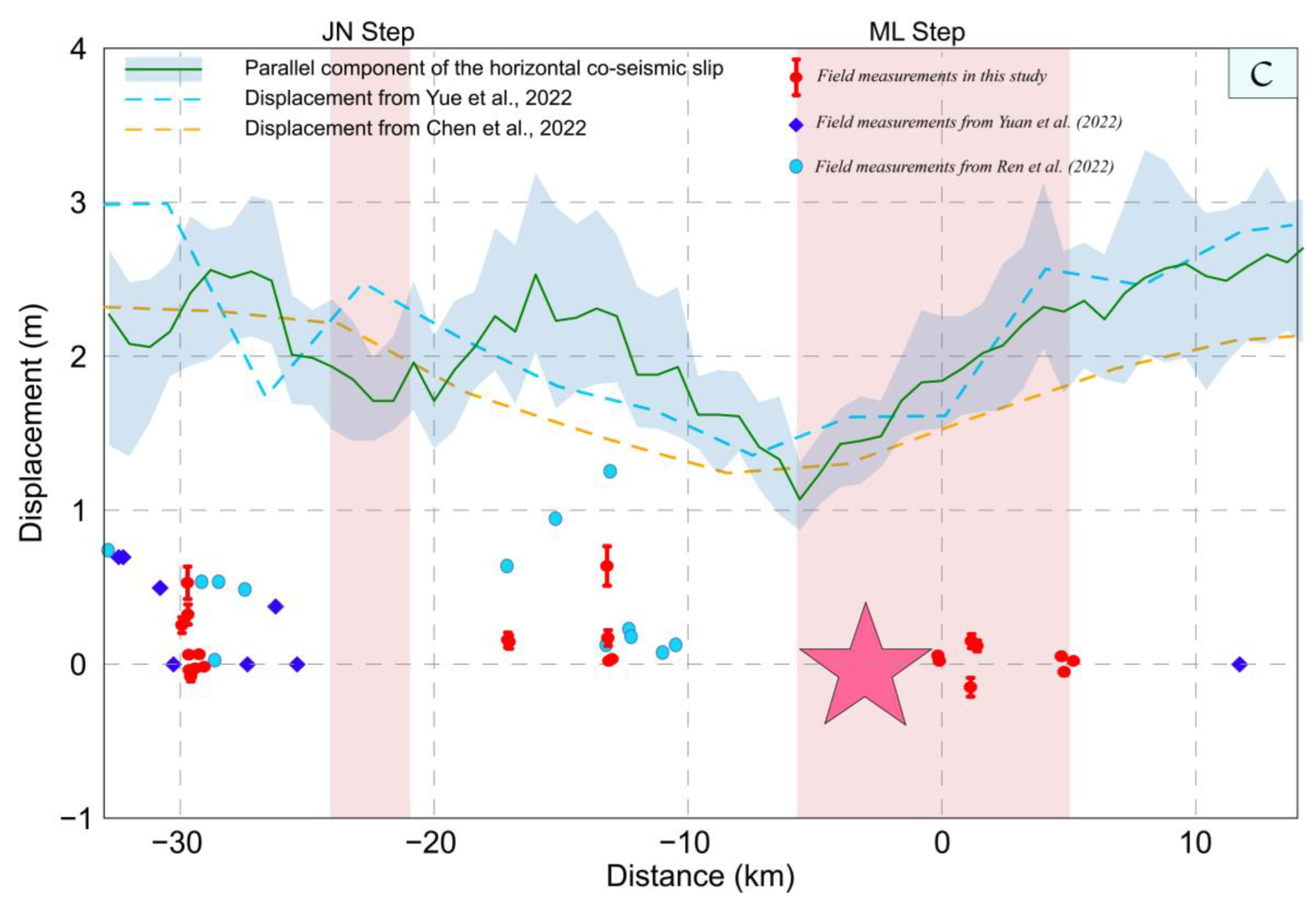
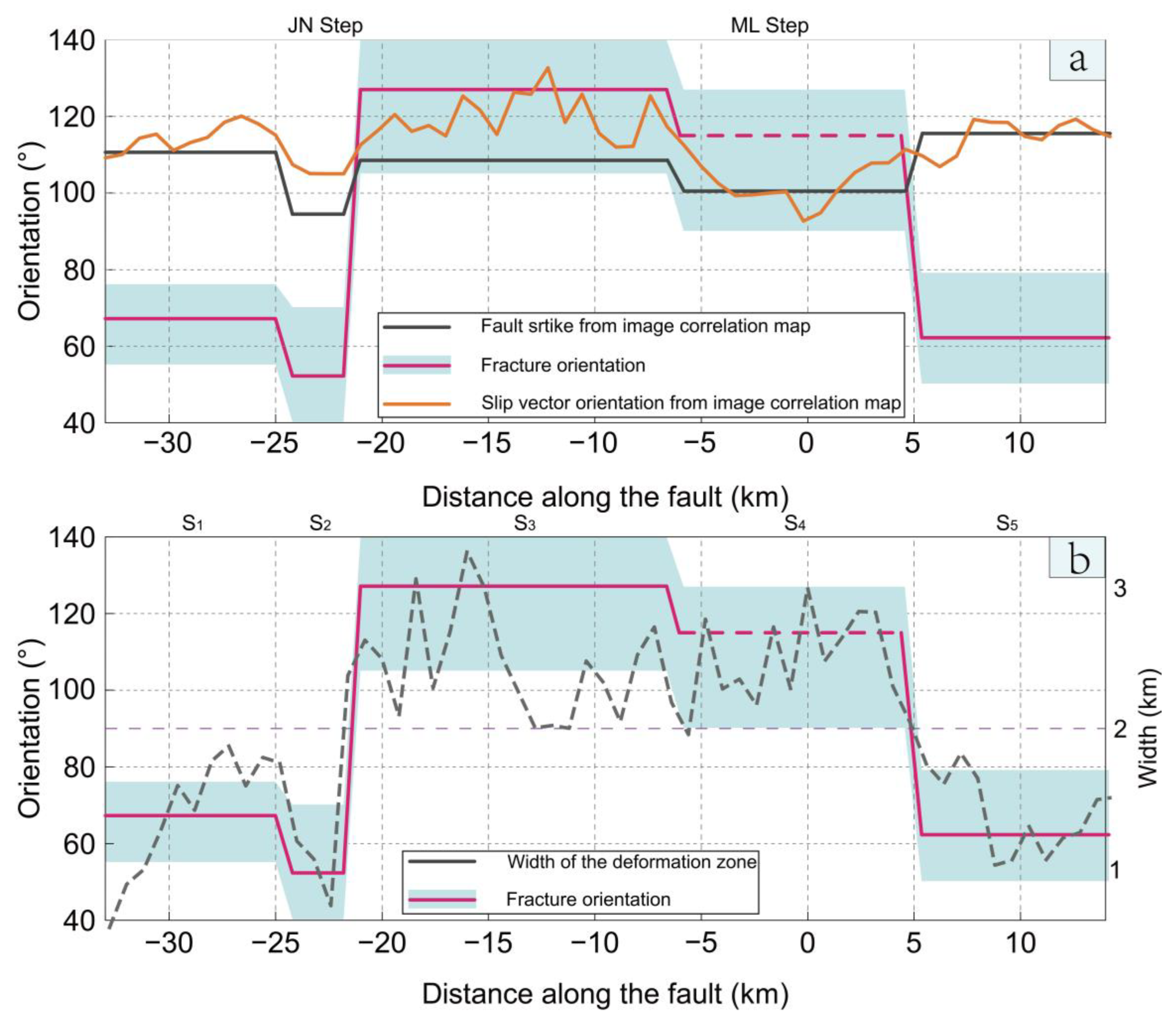
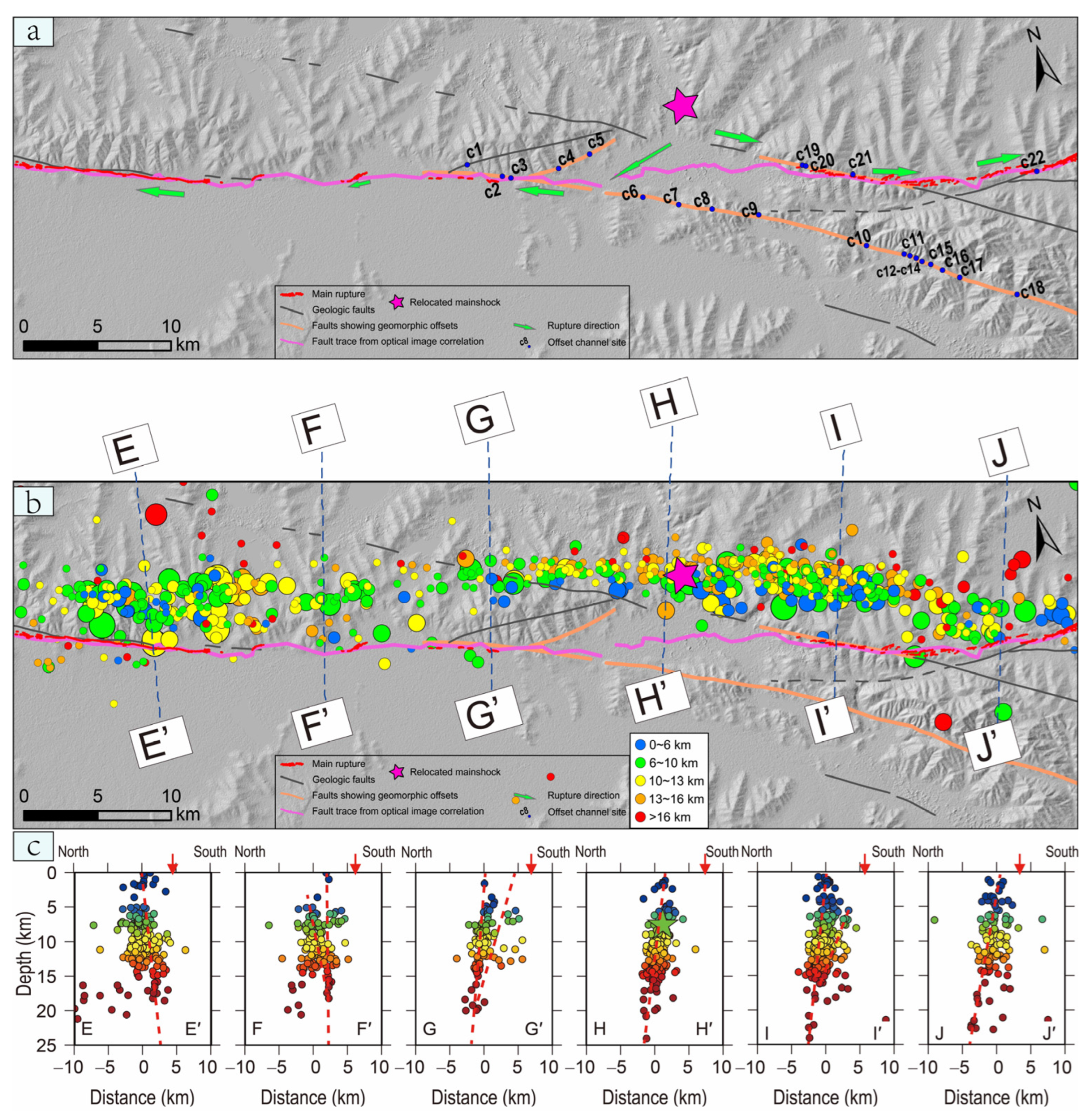
Disclaimer/Publisher’s Note: The statements, opinions and data contained in all publications are solely those of the individual author(s) and contributor(s) and not of MDPI and/or the editor(s). MDPI and/or the editor(s) disclaim responsibility for any injury to people or property resulting from any ideas, methods, instructions or products referred to in the content. |
© 2024 by the authors. Licensee MDPI, Basel, Switzerland. This article is an open access article distributed under the terms and conditions of the Creative Commons Attribution (CC BY) license (https://creativecommons.org/licenses/by/4.0/).
Share and Cite
Han, L.; Liu-Zeng, J.; Yao, W.; Wang, W.; Shao, Y.; Liu, X.; Zeng, X.; Gao, Y.; Tu, H. Discontinuous Surface Ruptures and Slip Distributions in the Epicentral Region of the 2021 Mw7.4 Maduo Earthquake, China. Remote Sens. 2024, 16, 1250. https://doi.org/10.3390/rs16071250
Han L, Liu-Zeng J, Yao W, Wang W, Shao Y, Liu X, Zeng X, Gao Y, Tu H. Discontinuous Surface Ruptures and Slip Distributions in the Epicentral Region of the 2021 Mw7.4 Maduo Earthquake, China. Remote Sensing. 2024; 16(7):1250. https://doi.org/10.3390/rs16071250
Chicago/Turabian StyleHan, Longfei, Jing Liu-Zeng, Wenqian Yao, Wenxin Wang, Yanxiu Shao, Xiaoli Liu, Xianyang Zeng, Yunpeng Gao, and Hongwei Tu. 2024. "Discontinuous Surface Ruptures and Slip Distributions in the Epicentral Region of the 2021 Mw7.4 Maduo Earthquake, China" Remote Sensing 16, no. 7: 1250. https://doi.org/10.3390/rs16071250
APA StyleHan, L., Liu-Zeng, J., Yao, W., Wang, W., Shao, Y., Liu, X., Zeng, X., Gao, Y., & Tu, H. (2024). Discontinuous Surface Ruptures and Slip Distributions in the Epicentral Region of the 2021 Mw7.4 Maduo Earthquake, China. Remote Sensing, 16(7), 1250. https://doi.org/10.3390/rs16071250







